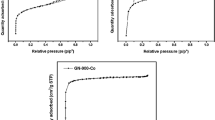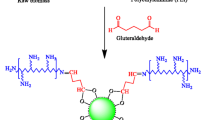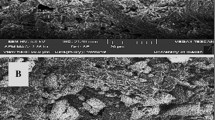Abstract
Metallic nanoparticles (NPs) have gained significant attention in recent years due to their efficiency in the adsorption of water pollutants. Except for magnetic NPs, metallic NPs are rarely used in oil sorption studies, due to the difficulty in recovering the NPs from the treated water. This study reports for the first time the application of ZnONPs for oil spill treatment. The ZnONPs were impregnated onto Musa acuminata peel (MP) support to form a novel material (ZnOMP), which was utilized for the sorption of oil from synthetic oil spills. The as-prepared sorbents were characterized by the SEM, EDS, BET, FTIR, FE-SEM, TGA, and XRD techniques. The presence of 31.32-nm average-sized ZnONPs enhanced the oil uptake characteristics, with clear affinity for the oil phase in comparison to the pristine MP. A maximum sorption capacity of 4.146 g/g and 5.236 g/g was obtained for biosorbents MP and ZnOMP, respectively, which was higher than most reported sorbents. The Freundlich model presented the best fit for the isotherm data, while the pseudo-second-order model was most suited for the kinetics. The presence of competing heavy metal ions in solution did not have any significant effect on the oil sorption capacity onto ZnOMP. The sorption mechanism was attributed to absorption and hydrophobic interactions. ZnONPs impregnated onto the biomass enhanced the spontaneity of oil uptake at higher temperatures. Over 82% desorption of the oil contaminant from the biosorbents was achieved during recovery, using petroleum ether and n-pentane as eluents. Concisely, ZnONPs enhanced the uptake and hydrophobic characteristic of MP biomass and showed good recovery and reusability. Thus, the application of ZnONPs impregnated onto biosorbents in oil spill treatment is highly recommended.












Similar content being viewed by others
Data availability
The datasets supporting the conclusion of this study are available from the corresponding author upon reasonable request.
References
Abdelwahab O (2014) Assessment of raw luffa as a natural hollow oleophilic fibrous sorbent for oil spill cleanup. Alexandria Eng J 53:213–218. https://doi.org/10.1016/j.aej.2013.11.001
Abdelwahab O, Nasr SM, Thabet WM (2017) Palm fibers and modified palm fibers adsorbents for different oils. Alexandria Eng J 56:749–755. https://doi.org/10.1016/j.aej.2016.11.020
Abhishek R, Hamouda AA, Abdulhameed FM (2019) Adsorption kinetics and enhanced oil recovery by silica nanoparticles in sandstone. Pet Sci Technol 37:1363–1369. https://doi.org/10.1080/10916466.2019.1587455
Achak M, Hafidi A, Ouazzani N et al (2009) Low cost biosorbent “banana peel” for the removal of phenolic compounds from olive mill wastewater: kinetic and equilibrium studies. J Hazard Mater 166:117–125. https://doi.org/10.1016/j.jhazmat.2008.11.036
Ahmad SZN, Salleh WNW, Yusof N et al (2020) Pb(II) removal and its adsorption from aqueous solution using zinc oxide/graphene oxide composite. Chem Eng Commun:1–15. https://doi.org/10.1080/00986445.2020.1715957
Akpomie KG, Conradie J (2020a) Banana peel as a biosorbent for the decontamination of water pollutants. A review. Environ Chem Lett 18:1085–1112. https://doi.org/10.1007/s10311-020-00995-x
Akpomie KG, Conradie J (2020b) Advances in application of cotton-based adsorbents for heavy metals trapping, surface modifications and future perspectives. Ecotoxicol Environ Saf 201:110825. https://doi.org/10.1016/j.ecoenv.2020.110825
Akpomie KG, Conradie J (2020c) Efficient synthesis of magnetic nanoparticle-Musa acuminata peel composite for the adsorption of anionic dye. Arab J Chem 13:7115–7131. https://doi.org/10.1016/j.arabjc.2020.07.017
Akpomie KG, Dawodu FA, Adebowale KO (2015) Mechanism on the sorption of heavy metals from binary-solution by a low cost montmorillonite and its desorption potential. Alexandria Eng J 54:757–767. https://doi.org/10.1016/j.aej.2015.03.025
Akpomie KG, Ezeofor CC, Olikagu CS et al (2018) Abstraction and regeneration potential of temperature-enhanced rice husk montmorillonite combo for oil spill. Environ Sci Pollut Res 25:34711–34719. https://doi.org/10.1007/s11356-018-3425-9
Akpomie KG, Onyeabor CF, Ezeofor CC et al (2019) Natural aluminosilicate clay obtained from south-eastern Nigeria as potential sorbent for oil spill remediation. J Afr Earth Sci 155:118–123. https://doi.org/10.1016/j.jafrearsci.2019.04.013
Alaa El-Din G, Amer AA, Malsh G, Hussein M (2018) Study on the use of banana peels for oil spill removal. Alexandria Eng J 57:2061–2068. https://doi.org/10.1016/j.aej.2017.05.020
AlAmeri K, Giwa A, Yousef L et al (2019) Sorption and removal of crude oil spills from seawater using peat-derived biochar: an optimization study. J Environ Manag 250:109465. https://doi.org/10.1016/j.jenvman.2019.109465
Ali I, Peng C, Khan ZM et al (2018) Green synthesis of phytogenic magnetic nanoparticles and their applications in the adsorptive removal of crystal violet from aqueous solution. Arab J Sci Eng 43:6245–6259. https://doi.org/10.1007/s13369-018-3441-6
Anuzyte E, Vaisis V (2018) Natural oil sorbents modification methods for hydrophobicity improvement. Energy Procedia 147:295–300. https://doi.org/10.1016/j.egypro.2018.07.095
Barka N, Abdennouri M, El Makhfouk M, Qourzal S (2013) Biosorption characteristics of cadmium and lead onto eco-friendly dried cactus (Opuntia ficus indica) cladodes. J Environ Chem Eng 1:144–149. https://doi.org/10.1016/j.jece.2013.04.008
Boleydei H, Mirghaffari N, Farhadian O (2018) Comparative study on adsorption of crude oil and spent engine oil from seawater and freshwater using algal biomass. Environ Sci Pollut Res 25:21024–21035. https://doi.org/10.1007/s11356-018-2281-y
Cao X, Yang G, Wei S, Han H (2011) Sorption of heavy oil onto Jiaozhou Bay sediment. Mar Pollut Bull 62:741–746. https://doi.org/10.1016/j.marpolbul.2011.01.016
Chukwuemeka-Okorie HO, Ekemezie PN, Akpomie KG, Olikagu CS (2018) Calcined corncob-kaolinite Combo as new sorbent for sequestration of toxic metal ions from polluted aqua media and desorption. Front Chem 6:1–13. https://doi.org/10.3389/fchem.2018.00273
Cruz GJF, Gómez MM, Solis JL et al (2018) Composites of ZnO nanoparticles and biomass based activated carbon: adsorption, photocatalytic and antibacterial capacities. Water Sci Technol 2017:492–508. https://doi.org/10.2166/wst.2018.176
Dawodu FA, Obioha UN, Akpomie K (2018) Removal of crude oil from aqueous solution by zinc chloride modified Discorea rotundata peel carbon: equilibrium, kinetic and intraparticle diffusivity. Pet Coal 60:985–994
Dawodu FA, Onuh CU, Akpomie KG, Unuabonah EI (2019) Synthesis of silver nanoparticle from Vigna unguiculata stem as adsorbent for malachite green in a batch system. SN Appl Sci 1:1–10. https://doi.org/10.1007/s42452-019-0353-3
Dawodu FA, Abonyi CJ, Akpomie KG (2021) Feldspar-banana peel composite adsorbent for efficient crude oil removal from solution. Appl Water Sci 11:3. https://doi.org/10.1007/s13201-020-01335-8
Doshi B, Sillanpää M, Kalliola S (2018) A review of bio-based materials for oil spill treatment. Water Res 135:262–277. https://doi.org/10.1016/j.watres.2018.02.034
Du W, Han X, Li Z, et al (2015) Oil sorption behaviors of porous polydimethylsiloxane modified collagen fiber matrix. J Appl Polym Sci 132:n/a-n/a. https://doi.org/10.1002/app.42727
Eze SI, Akpomie KG, Ezeofor CC et al (2019a) Isotherm and kinetic evaluation of Dialium guineense seed husk and its modified derivative as efficient sorbent for crude oil polluted water treatment. Water Conserv Sci Eng 4:21–31. https://doi.org/10.1007/s41101-019-00065-6
Eze SI, Akpomie KG, Ezeofor CC et al (2019b) Remediation of oil spill polluted water from Niger Delta Nigeria by sorption onto ammonium sulfate modified Dialium guineense seed husk. Pet Sci Technol 37:1830–1838. https://doi.org/10.1080/10916466.2019.1608240
Ezekoye OM, Akpomie KG, Eze SI et al (2020) Biosorptive interaction of alkaline modified Dialium guineense seed powders with ciprofloxacin in contaminated solution: central composite, kinetics, isotherm, thermodynamics, and desorption. Int J Phytoremediat 22:1028–1037. https://doi.org/10.1080/15226514.2020.1725869
Fakhari S, Jamzad M, Kabiri Fard H (2019) Green synthesis of zinc oxide nanoparticles: a comparison. Green Chem Lett Rev 12:19–24. https://doi.org/10.1080/17518253.2018.1547925
Fiore V, Piperopoulos E, Calabrese L (2019) Assessment of Arundo donax fibers for oil spill recovery applications. Fibers 7:75. https://doi.org/10.3390/fib7090075
Gammoun A, Tahiri S, Albizane A et al (2007) Separation of motor oils, oily wastes and hydrocarbons from contaminated water by sorption on chrome shavings. J Hazard Mater 145:148–153. https://doi.org/10.1016/j.jhazmat.2006.11.005
Gao S, Zhang W, An Z et al (2019) Adsorption of anionic dye onto magnetic Fe3O4/CeO2 nanocomposite: equilibrium, kinetics, and thermodynamics. Adsorpt Sci Technol 37:185–204. https://doi.org/10.1177/0263617418819164
Ghaedi M, Ansari A, Habibi MH, Asghari AR (2014) Removal of malachite green from aqueous solution by zinc oxide nanoparticle loaded on activated carbon: Kinetics and isotherm study. J Ind Eng Chem 20:17–28. https://doi.org/10.1016/j.jiec.2013.04.031
Gu M, Hao L, Wang Y et al (2020) The selective heavy metal ions adsorption of zinc oxide nanoparticles from dental wastewater. Chem Phys 534:110750. https://doi.org/10.1016/j.chemphys.2020.110750
Ibrahim HMM (2016) Biodegradation of used engine oil by novel strains of Ochrobactrum anthropi HM-1 and Citrobacter freundii HM-2 isolated from oil-contaminated soil. 3 Biotech 6:226. https://doi.org/10.1007/s13205-016-0540-5
Jiang H, Li J, Chen L, Wang Z (2020) Adsorption and desorption of chlorogenic acid by macroporous adsorbent resins during extraction of Eucommia ulmoides leaves. Ind Crop Prod 149:112336. https://doi.org/10.1016/j.indcrop.2020.112336
Jiao Y, Han D, Lu Y et al (2017) Characterization of pine-sawdust pyrolytic char activated by phosphoric acid through microwave irradiation and adsorption property toward CDNB in batch mode. Desalin Water Treat 77:247–255. https://doi.org/10.5004/dwt.2017.20780
Keshavarz A, Zilouei H, Abdolmaleki A, Asadinezhad A (2015) Enhancing oil removal from water by immobilizing multi-wall carbon nanotubes on the surface of polyurethane foam. J Environ Manag 157:279–286. https://doi.org/10.1016/j.jenvman.2015.04.030
Kumar R, Kumar G, Umar A (2013) ZnO nano-mushrooms for photocatalytic degradation of methyl orange. Mater Lett 97:100–103. https://doi.org/10.1016/j.matlet.2013.01.044
Liang Z, Chen L, Alam MS et al (2018) Comprehensive chemical characterization of lubricating oils used in modern vehicular engines utilizing GC × GC-TOFMS. Fuel 220:792–799. https://doi.org/10.1016/j.fuel.2017.11.142
Lu S-T, Kaplan IR (2008) Characterization of motor lubricating oils and their oil–water partition. Environ Forensic 9:295–309. https://doi.org/10.1080/15275920802119441
Lv N, Wang X, Peng S et al (2018) Superhydrophobic/superoleophilic cotton-oil absorbent: preparation and its application in oil/water separation. RSC Adv 8:30257–30264. https://doi.org/10.1039/C8RA05420G
Mohammed RR, Ibrahim IAR, Taha AH, McKay G (2013) Waste lubricating oil treatment by extraction and adsorption. Chem Eng J 220:343–351. https://doi.org/10.1016/j.cej.2012.12.076
Moradi Dehaghi S, Rahmanifar B, Moradi AM, Azar PA (2014) Removal of permethrin pesticide from water by chitosan–zinc oxide nanoparticles composite as an adsorbent. J Saudi Chem Soc 18:348–355. https://doi.org/10.1016/j.jscs.2014.01.004
Mousavi SB, Heris SZ, Estellé P (2020) Experimental comparison between ZnO and MoS2 nanoparticles as additives on performance of diesel oil-based nano lubricant. Sci Rep 10:5813. https://doi.org/10.1038/s41598-020-62830-1
Munagapati VS, Kim D-S (2017) Equilibrium isotherms, kinetics, and thermodynamics studies for Congo red adsorption using calcium alginate beads impregnated with nano-goethite. Ecotoxicol Environ Saf 141:226–234. https://doi.org/10.1016/j.ecoenv.2017.03.036
Nwadiogbu JO, Ajiwe VIE, Okoye PAC (2016) Removal of crude oil from aqueous medium by sorption on hydrophobic corncobs: equilibrium and kinetic studies. J Taibah Univ Sci 10:56–63. https://doi.org/10.1016/j.jtusci.2015.03.014
Olu-Owolabi BI, Diagboya PN, Ebaddan WC (2012) Mechanism of Pb2+ removal from aqueous solution using a nonliving moss biomass. Chem Eng J 195–196:270–275. https://doi.org/10.1016/j.cej.2012.05.004
Onwuka JC, Agbaji EB, Ajibola VO, Okibe FG (2018) Treatment of crude oil-contaminated water with chemically modified natural fiber. Appl Water Sci 8:86. https://doi.org/10.1007/s13201-018-0727-5
Sabir S (2015) Approach of cost-effective adsorbents for oil removal from oily water. Crit Rev Environ Sci Technol 45:1916–1945. https://doi.org/10.1080/10643389.2014.1001143
Sadegh H, Ali GAM, Gupta VK et al (2017) The role of nanomaterials as effective adsorbents and their applications in wastewater treatment. J Nanostructure Chem 7:1–14. https://doi.org/10.1007/s40097-017-0219-4
Saffarionpour S, Tam S-YS, Van der Wielen LAM et al (2019) Influence of ethanol and temperature on adsorption of flavor-active esters on hydrophobic resins. Sep Purif Technol 210:219–230. https://doi.org/10.1016/j.seppur.2018.05.026
Sani HA, Ahmad MB, Saleh TA (2016) Synthesis of zinc oxide/talc nanocomposite for enhanced lead adsorption from aqueous solutions. RSC Adv 6:108819–108827. https://doi.org/10.1039/C6RA24615J
Shokry H, Elkady M, Salama E (2020) Eco-friendly magnetic activated carbon nano-hybrid for facile oil spills separation. Sci Rep 10:10265. https://doi.org/10.1038/s41598-020-67231-y
Singaravelan R, Alwar SBS (2014) Effect of reaction parameters in synthesis, characterisation of electrodeposited zinc nanohexagons. J Nanostructure Chem 4:109–117. https://doi.org/10.1007/s40097-014-0121-2
Singh V, Kendall RJ, Hake K, Ramkumar S (2013) Crude oil sorption by raw cotton. Ind Eng Chem Res 52:6277–6281. https://doi.org/10.1021/ie4005942
Soliman EM, Ahmed SA, Fadl AA (2020) Adsorptive removal of oil spill from sea water surface using magnetic wood sawdust as a novel nano-composite synthesized via microwave approach. J Environ Health Sci Eng 18:79–90. https://doi.org/10.1007/s40201-019-00440-4
Stavrinou A, Aggelopoulos CA, Tsakiroglou CD (2018) Exploring the adsorption mechanisms of cationic and anionic dyes onto agricultural waste peels of banana, cucumber and potato: adsorption kinetics and equilibrium isotherms as a tool. J Environ Chem Eng 6:6958–6970. https://doi.org/10.1016/j.jece.2018.10.063
Tayeb AM, Farouq R, Mohamed OA, Tony MA (2020) Oil spill clean-up using combined sorbents: a comparative investigation and design aspects. Int J Environ Anal Chem 100:311–323. https://doi.org/10.1080/03067319.2019.1636976
Thanikaivelan P, Narayanan NT, Pradhan BK, Ajayan PM (2012) Collagen based magnetic nanocomposites for oil removal applications. Sci Rep 2:230. https://doi.org/10.1038/srep00230
Trinh VT, Minh T, Nguyen P et al (2020) Phosphate adsorption by silver nanoparticles-loaded activated carbon derived from tea residue. Sci Rep 10:3634. https://doi.org/10.1038/s41598-020-60542-0
Venkatanarasimhan S, Raghavachari D (2013) Epoxidized natural rubber–magnetite nanocomposites for oil spill recovery. J Mater Chem A 1:868–876. https://doi.org/10.1039/C2TA00445C
Wang J, Geng G (2015) Highly recyclable superhydrophobic sponge suitable for the selective sorption of high viscosity oil from water. Mar Pollut Bull 97:118–124. https://doi.org/10.1016/j.marpolbul.2015.06.026
Yao T, Zhang Y, Xiao Y et al (2016) The effect of environmental factors on the adsorption of lubricating oil onto expanded graphite. J Mol Liq 218:611–614. https://doi.org/10.1016/j.molliq.2016.02.050
Acknowledgments
The authors are grateful to the University of the Free State for the postdoctoral support granted to KGA. Concerning the current pandemic, we highly appreciate the management of the physical chemistry laboratory for access to the laboratory in order to complete these experiments.
Funding
This work was supported by the University of the Free State postdoctoral fellowship program.
Author information
Authors and Affiliations
Contributions
Kovo G. Akpomie: conceptualization, laboratory experiments, data analysis, writing original draft; Jeanet Conradie: supervision, funding acquisition, editing of the manuscript
Corresponding author
Ethics declarations
Competing interests
The authors declare that they have no conflict of interest.
Ethical approval
Not applicable
Consent to participate
Not applicable
Consent to publish
Not applicable
Additional information
Responsible Editor: Philippe Garrigues
Publisher’s note
Springer Nature remains neutral with regard to jurisdictional claims in published maps and institutional affiliations.
Rights and permissions
About this article
Cite this article
Akpomie, K.G., Conradie, J. Enhanced surface properties, hydrophobicity, and sorption behavior of ZnO nanoparticle–impregnated biomass support for oil spill treatment. Environ Sci Pollut Res 28, 25283–25299 (2021). https://doi.org/10.1007/s11356-021-12451-6
Received:
Accepted:
Published:
Issue Date:
DOI: https://doi.org/10.1007/s11356-021-12451-6




